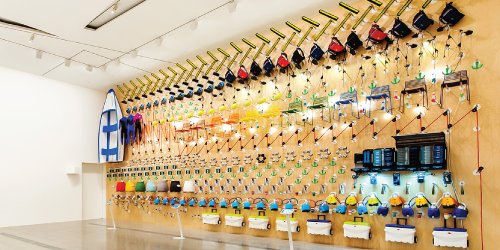Image: Simone LeAmon and Edmund Carter, Design Wall (2013) Melbourne Now, National Gallery of Victoria, Australia, Ian Potter Centre. Supported by the Hugh D.T. Williamson Foundation.
With unique reach across subjects, contexts and domains there are few aspects of human existence not touched by design. Our lives are shaped by the things we continuously create – technologies, processes, environments, ways of thinking, systems, services and objects – every day we carry out our lives in the company of things that are influencing the way we think, do and feel.
As a curator of contemporary design I am interested in understanding the decisions that people make when engaged in the activity of design. Design along with the sciences, arts and humanities, belongs to an intellectual and practical tradition of human inquiry. Design enables us to create the conditions, systems and objects to facilitate remarkable things. It can unlock the best of human potential. This capability, however, comes at a price, for human beings can also design and deliver unremarkable, spurious and threatening things.
Framing our understanding of design is more important now than ever before. Design is not simply about styling or the manufacture of commercial goods; it is an agency for deliberate creation and intentional change. This is why design holds a special place in creative, critical and commercial dialogues. Throughout history, designers of all types have conceptualised objects, services and systems that did not yet exist in the real world. Applying their creativity in the service of the extraordinary, designers have raised as many questions as they have provided answers. Once seen as a drawback, speculation and experimentation are now enthusiastically pursued by contemporary design practitioners.
To paraphrase UK based design writer and critic Alice Rawsthorn, the complex nature of international contemporary design practice means that ‘good design’ is no longer principally industrial, commercial, mass-produced, client-driven or the domain of trained professionals under instruction(1). It is more common now to encounter designers who invest in their own design ideas and production. Here, the designers are authors, conscious of their creative potential and applying it to make sense of designing and making in the here and now.
Delivering a valuable platform to critique and champion design, cultural institutions across Australia are now examining design with the same rigour they apply to understanding art. The new Department of Contemporary Design and Architecture at the National Gallery of Victoria is evidence of this. Understanding design in this way allows us to position contemporary practice in a broader cultural field, enriching our cultural experience.
Simone LeAmon
Hugh Williamson Curator of Contemporary Design and Architecture
National Gallery of Victoria
(1) What is Design? Frieze, April 2014, p. 162.







